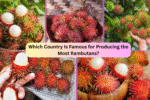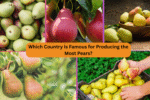Figs, with their luscious sweetness, chewy texture, and ancient cultural significance, are among the oldest cultivated fruits in human history. Beloved for their rich flavor and nutritional benefits, figs appear in both modern health trends and classic Mediterranean dishes. But have you ever stopped to ask — where does the world get most of its figs?
In this article, we’ll take a comprehensive look at the global fig industry, highlight the major fig-producing nations, trace how figs travel from orchards to consumers worldwide, and discover why certain countries dominate the fig trade.
A Brief History of Figs

Figs (Ficus carica) originated in Western Asia and the Middle East, where evidence of fig cultivation dates back over 5,000 years. Ancient Egyptians, Greeks, and Romans considered figs a symbol of fertility, prosperity, and health. Over centuries, fig trees spread throughout the Mediterranean basin, North Africa, and eventually to parts of Asia, the Americas, and Australia.
Today, figs remain a prized fruit, enjoyed fresh, dried, or preserved — with growing popularity in gourmet desserts, energy bars, jams, and plant-based diets.
Where Does the World Get Most of Its Figs?

When it comes to global fig production and export, one country stands out as the unrivaled leader: Turkey.
Alongside Turkey, countries like Egypt, Morocco, Iran, Algeria, Spain, and the United States (California) play significant roles in supplying the world with figs, particularly in their dried form, which dominates international trade due to its long shelf life.
Let’s take a closer look at the top fig-producing and exporting countries.
Turkey: The World’s Largest Fig Supplier

Turkey is the undisputed giant in the global fig market. The country accounts for roughly 23% of the world’s total fig production and over 50% of global dried fig exports.
Why Turkey Dominates:
- Ideal Mediterranean Climate: Particularly in the Aegean region, where hot, dry summers and mild, wet winters nurture the perfect fig-growing environment.
- Historical Cultivation Expertise: Figs have been cultivated in Turkey for millennia, with traditional farming knowledge passed down through generations.
- Superior Fig Varieties: Turkey’s famous ‘Sarı Lop’ fig is highly sought after for its size, sweetness, and exceptional drying quality.
- World-Class Processing Facilities: Turkey boasts state-of-the-art infrastructure for drying, packaging, and exporting figs globally.
Turkey’s Production and Export:
- Annual Production: 310,000–330,000 metric tons
- Primary Export Markets: Germany, France, Italy, the United States, China, and the Middle East
The Aegean province of Aydın is known as the “fig capital of the world,” supplying the highest-quality figs globally.
Egypt: A Strong Domestic and Export Supplier

Egypt ranks as the world’s second-largest fig producer, with fertile lands in the Nile Delta and Mediterranean coastal areas offering excellent conditions for fig cultivation.
Highlights:
- Primarily supplies the domestic market
- Growing exports to the Middle East and Europe
- Mix of fresh and dried figs
Production:
- Annual Production: 270,000–290,000 metric tons
- Key Markets: Middle Eastern countries and select European markets
Morocco: Mediterranean Excellence
Morocco is another important player, growing figs across its mountain valleys and coastal regions. Moroccan figs are cherished both fresh and dried, with exports mainly targeting France, Spain, and the UAE.
Production:
- Annual Production: 130,000–140,000 metric tons
Iran: Ancient Heritage, Modern Production

Iran boasts a long-standing tradition of fig farming, particularly in the southern region of Estahban, known for producing some of the world’s best dried figs.
Production:
- Annual Production: 70,000–80,000 metric tons
- Primarily dried fig exports to Asian and Middle Eastern markets
Algeria: North African Contributor
Algeria is another North African country contributing substantially to the global fig supply, primarily for local consumption, though exports are steadily growing.
Production:
- Annual Production: 60,000–70,000 metric tons
How Figs Are Distributed Globally
While figs are grown in many countries, international fig trade is dominated by dried figs due to their extended shelf life, ease of transport, and versatile uses in baking, snacking, and cooking.
Major Exporters:
- Turkey
- Iran
- Spain
- Greece
- United States (California)
Major Importers:
- Germany
- France
- United States
- Italy
- China
- United Arab Emirates
Turkey’s Aegean region alone exports thousands of tons of dried figs annually, especially during the winter holiday season in European markets.
Top 5 Fig Producing Countries (Approx. Annual Production)
| Rank | Country | Production (Metric Tons) |
|---|---|---|
| 1 | Turkey | 310,000–330,000 |
| 2 | Egypt | 270,000–290,000 |
| 3 | Morocco | 130,000–140,000 |
| 4 | Iran | 70,000–80,000 |
| 5 | Algeria | 60,000–70,000 |
Why Figs Are in High Demand Worldwide
Several factors have contributed to the steady global demand for figs:
- Rich Nutritional Profile: Figs are packed with dietary fiber, antioxidants, vitamins, and natural sugars.
- Health and Wellness Trends: Increasing popularity as a natural sweetener, digestive aid, and immune booster.
- Culinary Versatility: Used in Mediterranean, Middle Eastern, and contemporary global cuisines.
- Plant-Based Lifestyles: Favored in vegan, vegetarian, and gluten-free recipes.
This rising popularity ensures figs remain a staple in export markets and health food stores worldwide.
Challenges in Global Fig Production
Despite the growing demand, fig farming faces several challenges:
- Climate Vulnerability: Figs require hot, dry summers and mild winters — making them sensitive to climate change and extreme weather.
- Perishability: Fresh figs have a very short shelf life (about a week), limiting long-distance trade of fresh produce.
- Pests and Disease: Fig trees are susceptible to fungal diseases and pests, requiring vigilant farm management.
- Labor-Intensive Harvesting: Most fig varieties must be handpicked to avoid bruising.
Countries like Turkey have countered these challenges through advanced irrigation systems, research on disease-resistant varieties, and improved drying techniques.
Conclusion: Where Does the World Get Most of Its Figs?
The global fig supply chain begins predominantly in Turkey, where rich Mediterranean lands and centuries of expertise have made it the top producer and exporter of figs — particularly the world-famous ‘Sarı Lop’ dried fig. Egypt, Morocco, Iran, and Algeria follow as significant contributors, supplying both local markets and international buyers.
In international trade, dried figs account for the majority of global fig exports, with Turkey alone controlling over 50% of that market. From the sun-drenched orchards of Aydın to gourmet bakeries in Paris and health food stores in New York, figs have traveled a remarkable journey to reach consumers around the world.
So next time you savor a sweet, chewy fig — fresh or dried — chances are it came from the fertile lands of Turkey, the global heart of fig production.




Leave A Comment